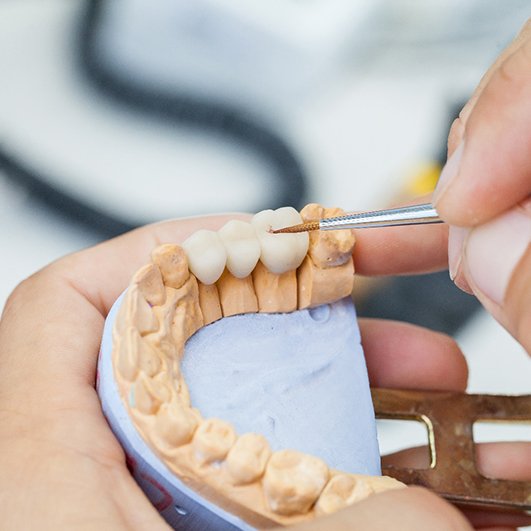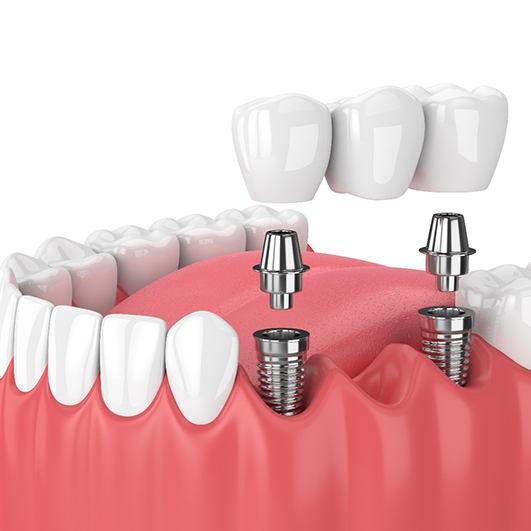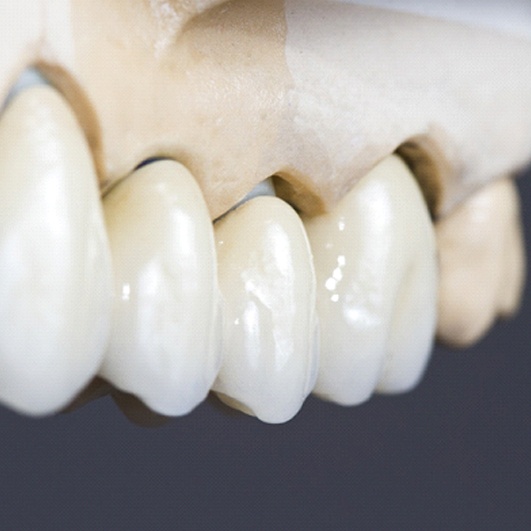
Dental Bridges – Brick Township, NJ
Comprehensive, Natural-Looking Tooth Replacement
Tooth loss affects over 180 million Americans every day, but there are solutions available to you in the event you lose a tooth. Whether it was due to tooth decay, gum disease, physical injury or something else, Dr. Gizachew can create a fully customized restoration designed to replace single and multiple consecutive teeth. Give our office a call to schedule a consultation and speak with our team directly about your needs and learn which restorative treatment can best invigorate your smile!
What is a Dental Bridge?

Dental bridges are used if you are missing one or more consecutive teeth along the top or bottom row of your mouth. Relying on dental crowns that are fused to create the bridge, this restorative treatment uses your healthy abutment teeth as anchors to hold the bridge in place.
The exterior crowns are placed over the natural teeth while the interior crowns sit on top of the gums, creating the appearance of a fully restored smile.
This minimally invasive procedure takes the same amount of time (two visits) and will leave you feeling more confident in your appearance.
Types of Dental Bridges

There are two main types of dental bridges to consider when replacing teeth. Our office can provide both of them depending on your needs and preferences. This includes traditional dental bridges and implant bridges, both of which have unique benefits to consider with Dr. G. During your consultation, you’ll be able to learn which option is best for you. To learn more, read on below to get an idea of how both of these tooth replacements work!
Traditional Dental Bridge
A traditional dental bridge consists of multiple crowns fused together (typically three) with the crowns on either end of the restoration hollowed out. This allows them to attach to existing teeth in your smile that have been modified to hold the bridge. The crown(s) in between (or pontics) effectively fill the gap. With regular care, you can expect your bridge to last 10 years or longer.
Implant Bridge
With the help of dental implants, your bridge can not only last much longer (and potentially for life), but provide additional benefits. For example, once the implants are placed inside your jaw, your bone tissue gets the stimulation it needs to improve your biting strength. However, implant bridges do take far more time to receive, are considerably more expensive, and require having enough healthy bone tissue to place.
The Benefits of Getting a Dental Bridge

Although there are other available options for tooth replacement, dental bridges continue to stand the test of time. As one of the safest, most reliable solutions on the market, your dentist can attest to the tremendous benefits you’ll receive, such as:
- A more beautiful, complete look that allows you to exude the confidence you deserve
- A prosthetic that keeps natural, healthy teeth in place and prevents them from shifting out of alignment and causing potential orthodontic intervention
- Improved functionality when chewing because the force is more evenly distributed throughout your arch
- The ability to speak with greater clarity
Dental Bridge FAQs

We understand you may have questions about your tooth replacement options and how it can feel a bit overwhelming at first. When you visit Nu Dental Brick, you can expect Dr. G and his team to be happy to go over all your options one-on-one and answer questions you need addressed. In the meantime, feel free to read over the responses to some of our most commonly asked questions below for your convenience.
Is Getting a Dental Bridge Painful?
Prior to preparing your teeth to receive a dental bridge, we will effectively numb your tooth and surrounding gum tissue in order to prevent any sensations from being felt during the preparatory phase. This is done with a topical anesthetic, but we can also administer sedation dentistry if needed to help you relax. Once the restoration is created and placed, you can expect your underlying teeth to feel a little sensitive for the next few days. This can be easily managed with over-the-counter medications, but don’t hesitate to call our office if your discomfort does not improve. If you choose implant bridges to replace teeth, you may need to set aside a few days to take it easy (which is common following any oral surgery).
Can You Take a Dental Bridge Out?
Dental bridges are not designed to come out once they have been placed. In fact, they are designed to stay there for many years (typically around 10 in most cases). You should not be able to take them out on your own – if they must come out, it should only be done by a dentist. If it were to be removable, it would no longer be a dental bridge but closer to a “partial denture” instead. Even then, this is not exactly accurate. Partials are similar to bridges, but the main difference is dentures can be removed as needed, while bridges cannot.
How Many Teeth Can a Dental Bridge Replace?
While it truly depends on the patient’s needs, dental bridges can replace anywhere from one to four missing teeth in a row. With that said, it’s far more common to only have one to two teeth replaced through a bridge. If the bridge becomes too long, it can become unstable, particularly if the natural teeth supporting it are not strong or healthy enough. It can become too risky to replace three or more teeth at a time in this circumstance. An implant bridge may be more effective at reducing long-term risks, but you may also want to explore partial dentures just in case.
Do Dental Bridges Look Natural?
Our dental bridges are designed to be metal-free. Specifically, they are made from dental porcelain that’s custom-shaded to blend in with your existing teeth. Since these materials look indistinguishable from your natural enamel, you can smile with confidence knowing only you and our office are aware of your tooth replacement. Even light naturally reflects off your bridge the same way as natural teeth thanks to our polishing process.